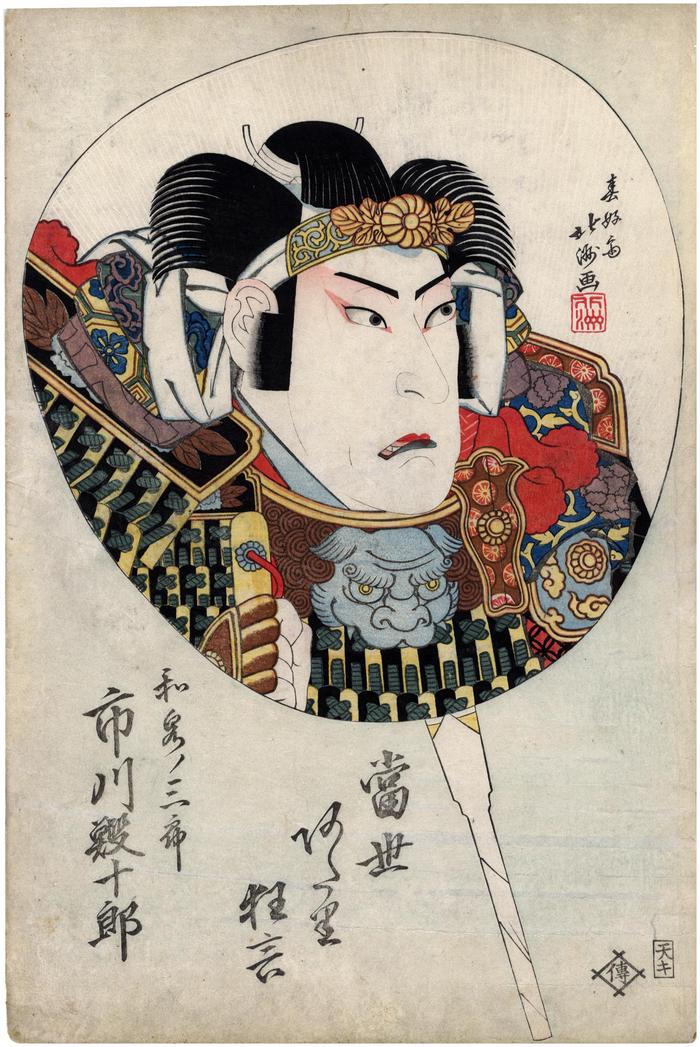Shunkōsai Hokushū (春好斎北洲) (artist ca 1808 – 1832)
Ichikawa Ebijūrō I (市川鰕十郎) as Izumi no Saburō (和泉ノ三郎) from the series Current Hit Plays (Tōsei atari kyōgen - 當世阿た里狂言)
03/1825
10 in x 15 in (Overall dimensions) Japanese color woodblock print
Signed: Shunkōsai Hokushū ga
春好斎北洲画
Publishers:Tenmaya Kihei
(Marks 536 - seal 25-435) and
Izutsuya Denbei (Marks 186 - seal 07-030)
Museum of Fine Arts, Boston
Waseda University
Lyon Collection - Ca. 1830 Kuniyoshi print of Saburō's wife in battle
Hankyu Culture Foundation
Musées royaux d'art et d'histoire Ichikawa Ebijūrō I depicted on a fan dressed as a samurai general from the play Yoshitsune Koshigoe-jō (義経腰越状) performed at the Kado Theater in 1825/3. The background blind-printed with a ribbed pattern. This series of fan portraits is extremely scarce and is rarely found untrimmed. This print is full size.
If you look closely at Ebijūrō's lower lip you will notice it is inked in a darker color and is not red like the upper lip. In fact it would have been green or an iridescent green. Why? It would seem at this time that actors in male roles in Osaka sometimes used sasabeni (笹紅) an expensive cosmetic used mainly by courtesans in Edo.
****
"This print...[is from a set of at least seven prints.] The set is related to three kabuki plays performed in 3/1825 at the Kado Theatre and shows the actor Nakamura Utaemon on five prints, and Ichikawa Ebijūrō I on two.
In early 1825 Utaemon announced to retire from the stage and in 3/1825 he played in farewell performances. On the occasion of these many prints were published, and encouraged by the great success of the performances he decided to continue acting.
The set was published by different publishing houses and some of the prints, if not all, were created with the aid of the carver Kasuke and the printer Zakoba.
This portrait of Ebijūrō I, shown here, only recently became known by an illustration in prof. Matsudaira's 'Hokushū to Toyokuni' (pl. 54). It is the only one in the set on which the publisher's trademark 'Den' is present."
Quoted from: Ōsaka Kagami 大阪鏡 by Jan van Doesburg, p. 54, #42, 1985.
****
Before kabuki there was the puppet theater and before these there were nō and kōwaka (幸若), a form of dance performance often based on military themes. We are mentioning this because Izumi no Saburō was being featured long before kabuki. "In Izumi's Fortress, Izumi no Saburō sacrifices his whole family in order to honor a pledge of loyalty to Yoshitsune. The motif in Izumi's Fortress, [is] avarice as the cause of infidelity....
Then there are the heroic women who are even bolder, more circumspect, and more self-reliant than their gallant men. Izumi's wife has the courage to see her children deliberately killed lest Izumi's concern for their safety sway his determination to honor his pledge of loyalty; she fights alongside him, and in the end, when they are about to take their own lives, she has the presence of mind to make certain that her husband kills himself in a manner becoming a samurai."
Quoted from: The Ballad-drama of Medieval Japan by James T. Araki, p. 116.
****
Illustrated
1) in color in Ikeda Bunko, Kamigata yakusha-e shūsei (Collected Kamigata Actor Prints), vol. 1, Ikeda Bunko Library, Osaka 1997, no. 159.
2) in black and white in black and white in Ōsaka Kagami 大阪鏡 by Jan van Doesburg, Huys den Esch, 1985, page 54, #42.
Ichikawa Ebijūrō I (初代市川鰕十郎 9/1815 to 7/1827) (actor)
Kyōto-Osaka prints (kamigata-e - 上方絵) (genre)
actor prints (yakusha-e - 役者絵) (genre)
Izutsuya Denbei (井筒屋伝兵衞) (publisher)
Tenmaya Kihei (天満屋喜兵衛) (publisher)
